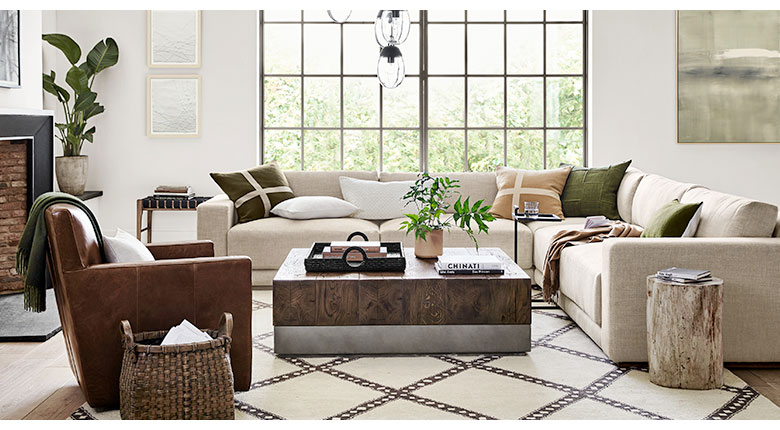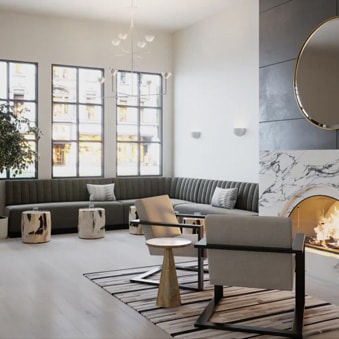How to Choose a Room Color Palette
Color is one of the easiest and most affordable decorating tools but it requires careful thought and planning. Learn how to select the colors that are best for the mood and ambience you’re trying to achieve.

Painting your room, or really adding color in any form, is an easy and affordable way to dramatically change the look and feel of your room. Choosing a room’s color palette, which may be one of the first steps you take when decorating, is also a very personal choice and requires careful thought and planning. The good thing is that there are no absolute rules of color. Read on for our top tips on how to choose a room color palette.

Methods of Choosing a Color Palette
There are two different methods you can use to determine a color palette you’ll love in your space.
The first method is to use photos of spaces you admire to identify colors that appeal to you. Pull together photos from catalogs, magazines, websites, and you name it. Analyze any similarities in the photos for any indication of color schemes you may like. Do most of the pictures you’re drawn to reflect warms, cools,or neutrals? Do you like rooms with low or high contrast? Once you’ve landed on a general grouping, select a palette of three or four main colors to be reflected in the walls, upholstery, and accessories. The general guideline when decorating is to use three different values: light, medium,and dark. But, keep in mind that there are no hard and fast rules when it comes to color.
The second method is to pull colors from a pattern or artwork that inspires you. Simply create a color palette by picking up three or four major colors from the print of a pillow, rug, piece of art, or even a fashion item that you’re drawn to.

Identifying a Color Scheme for a Furnished Room
If your room is already furnished or semi-furnished, and you want to create a new color palette, or flush out the palette, there are a few ways to go about it. If you plan to keep your furniture but wants to update the textiles, find a patterned fabric or piece of artwork in the room and then select window hardware and panels, a rug, and/or textiles like pillows and throws that bring out one of these colors. If everything in the room—the floors, the sofa, and the chairs—is solid and has no pattern, consider choosing a patterned drapery, rug, or textile that incorporates colors from the sofa, chair, and floor. Don’t spend too much effort trying to match colors exactly; Having varying shades of a color gives a space a less artificial look.
Don’t overthink it: If you focus on an accent color that you already have, you can easily bring out more of it with a few accessories. Place colorful pillows and throws on furniture throughout the room for an easy color update. A solid pillow for a patterned side chair, or different colored pillows for a solid, neutral sofa will add comfort and just the right splash of color.

How to Determine the Right Paint Color for Your Space
An important part of determining your room’s color palette, of course, is selecting the paint color for your walls. There are a helpful tips to do so.
If you have darker furniture, use a lighter paint color for the walls and vice versa with lighter furniture. When in doubt, go for whites and neutrals, which are the most common paint colors, because they make it easy to bring other colors into the space via decor.
You can also match the paint color to an accessory in the room, such as a pillow or your inspiration pattern (in that case, usually the lightest color in the pattern is used is a safe bet). Bring that item with you to the paint color and have the store clerk match it for color accuracy. If there is an adjoining room or hallway that you would like to coordinate with the room you are painting, we recommend you bring a paint chip of the existing paint color as well.
Remember to paint the ceiling before doing the walls to avoid splashing the new paint work. Lighter colors are typically best for ceilings. If you’d like the ceiling to match the wall color, we recommend buying an additional paint color one or two shades lighter than the wall paint.
We also advise that you purchase the correct amount of paint at the outset and select tins with the same batch number; otherwise there might be slight variations in the color. If the color is pre-mixed, recommend they record the batch number in case additional paint is required.

Work with an Interior Designer
Williams Sonoma Home offers free design services to our customers. Work with our stylists and decorators, in your home or at your local store, to create your dream home. Schedule an appointment with the Williams Sonoma Design Crew or work with your local store to get started.








